When people think of the end of the Cold War, they think of the fall of the Berlin Wall or of Boris Yeltsin standing on a tank in the Red Square. Me, I think of the Dark Knight fighting a dude with an S&M outfit, a luchador mask, and a bayonet for a hand.
I’ve already mentioned some of the kooky adventures Batman and his teammates go through in the 1980s, but the impact of the international scene spreads much further, with Gotham characters showing up in Cold War-inspired comics across the DC Universe. Dick Grayson leads the Teen Titans, who deal with the obligatory nuclear threat story in ‘When the Sun Goes Black!’ by facing a domestic cult devoted to atomic power. Commissioner Gordon has a small role in Paul Kupperberg’s and Mike Mignola’s underrated Phantom Stranger miniseries, where Soviet/American tension brings the world to the brink of Armageddon. Two members of Batman’s rogues’ gallery help carry out a secret mission in Russia, in a typically awesome Suicide Squad story arc…
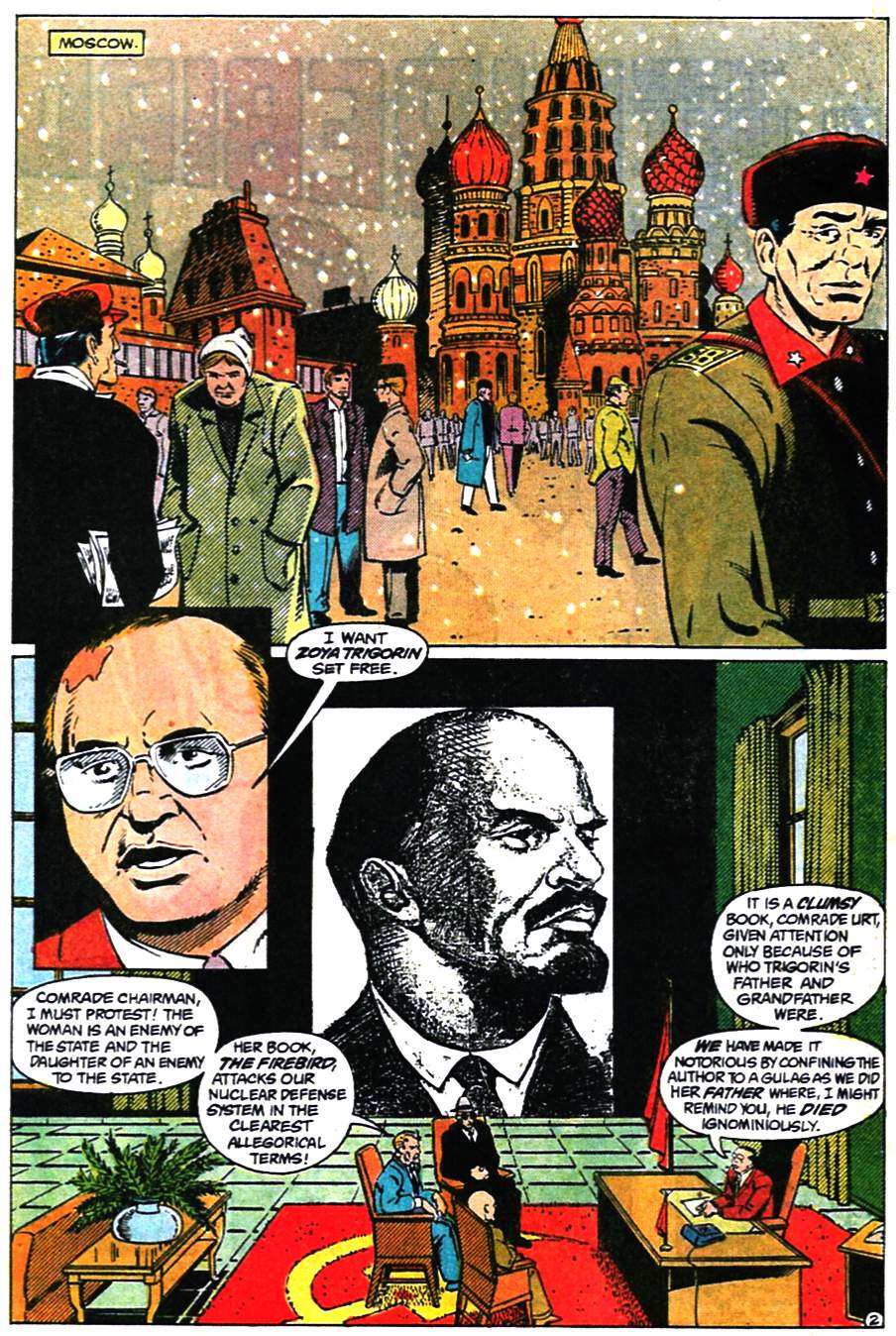
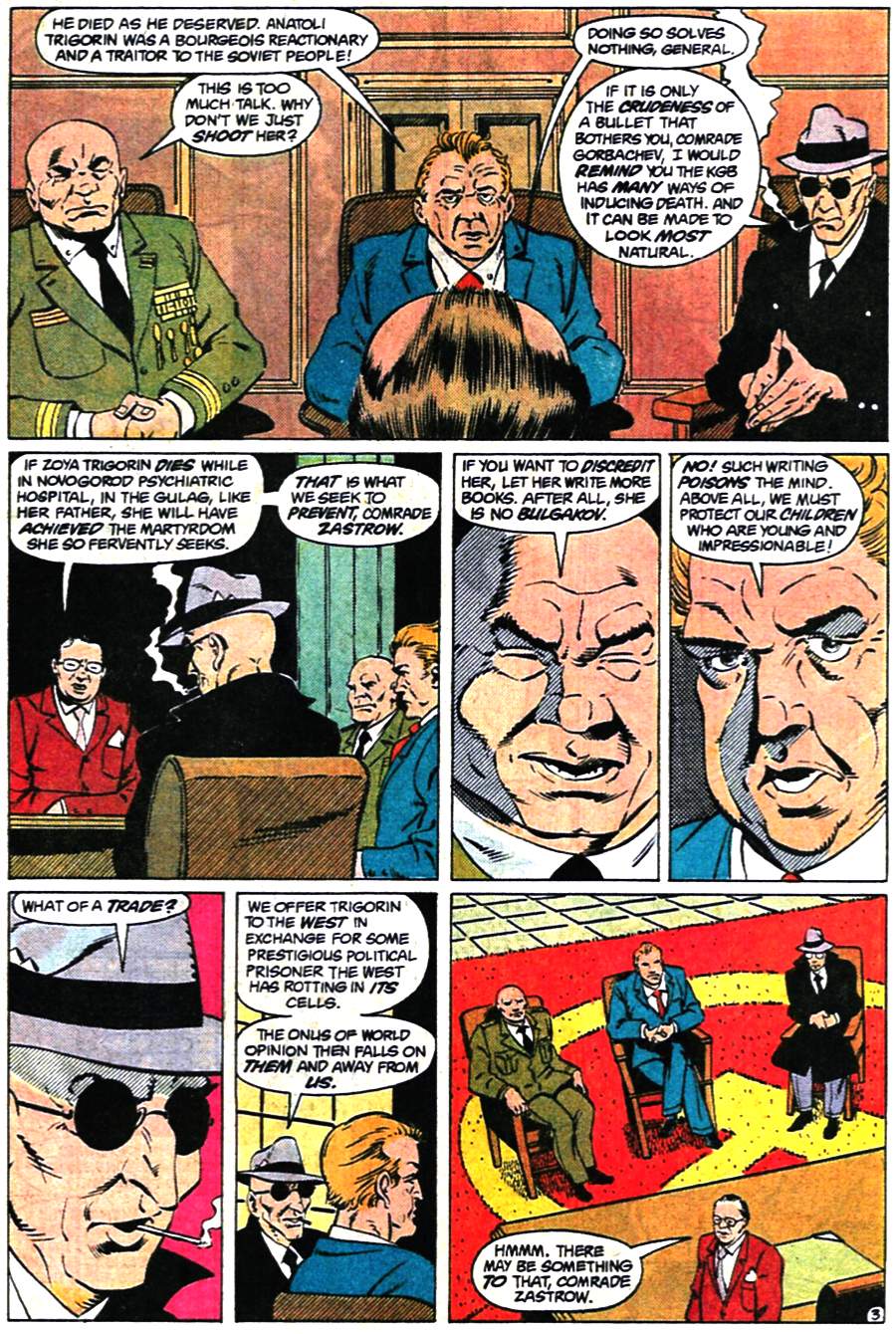 Suicide Squad #5
Suicide Squad #5
For propaganda purposes, Washington sends the Suicide Squad to rescue a Russian political prisoner. Their task force includes the Penguin – assigned with planning, since the operation is basically a heist, only in a gulag – and Deadshot – who speaks fluent Russian, having picked it up together with a Communist Party card to piss off his father. As it often happens with Suicide Squad missions, however, everything hits the fan:
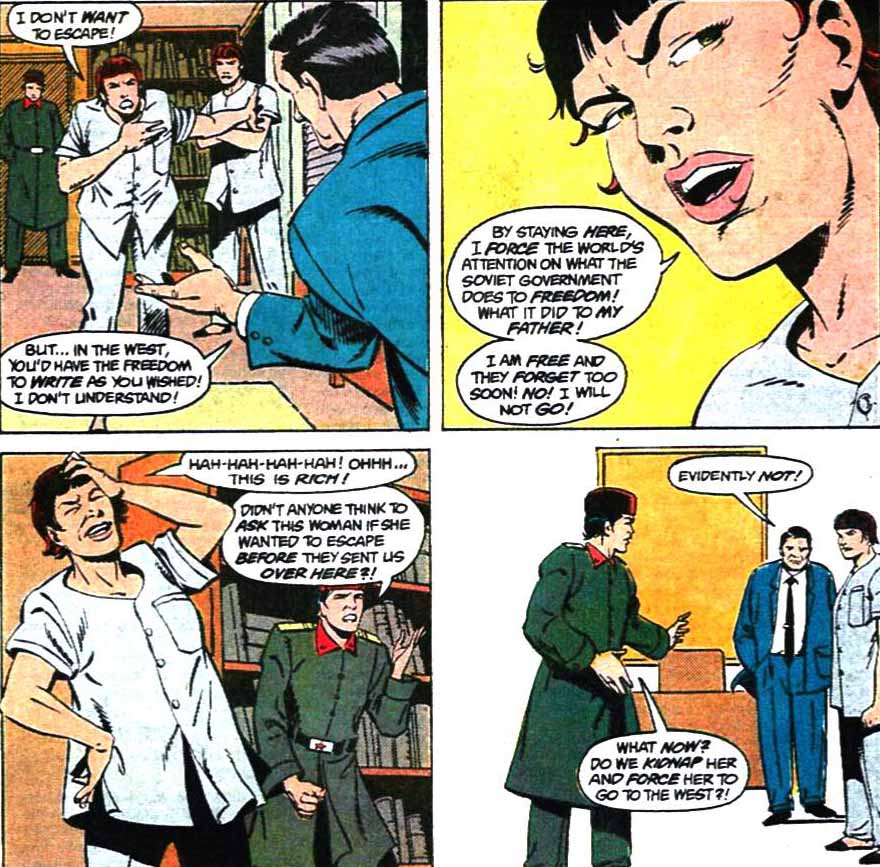 Suicide Squad #5
Suicide Squad #5
Things go so wrong, in fact, that a team member (Nemesis) is thrown to the wolves, requiring a second rescue mission later in the series. That’s when all hell breaks loose: Moscow puts pretty much every Soviet superhero on the case and, in order to prevent a diplomatic crisis, President Ronald Reagan agrees to send in the JLI to stop the Squad, although not without some horsing around first:
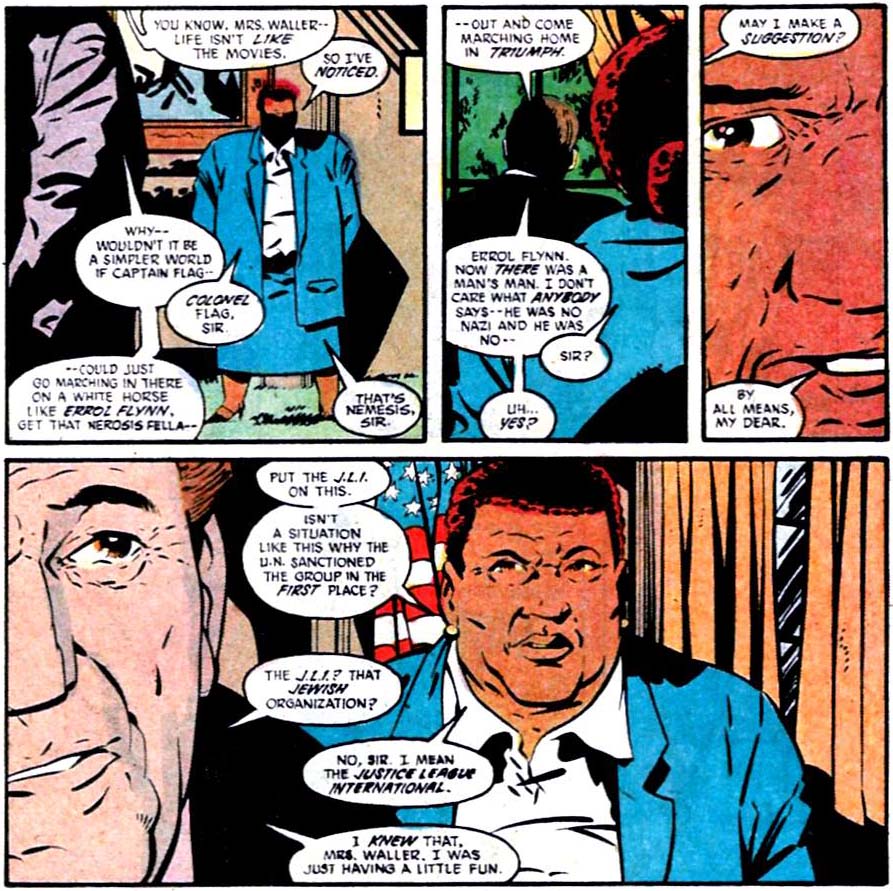 Justice League International #13
Justice League International #13
As a result, everybody gets their ass kicked at a showdown in a Russian prison. Including Batman!
One of the many cool things about this story is that it reflects how complicated the relationship between US and USSR can be, far from a simple rivalry. This awareness can likewise be seen in the fact that a plot device which gets reused in various comics is the notion of rogue Soviet agents attacking the US on their own in order to provoke a conflict that shakes the USSR’s appeasement tendencies. It is quite the convenient trope, as it allows for stories with clichéd Russian villains while also acknowledging that Moscow does seem to be on the path to reform, usually culminating in amusing team-ups between Soviet and American characters. For example, when Fusion goes insane and tries to blow up the Statue of Liberty, the maverick Outsiders, the right-wing Force of July, and the socialist People’s Heroes actually join forces to prevent world war, in what has to be one of the most offbeat instances of superpower cooperation.
Similarly, in 1982 a grief-stricken minor Soviet official sends a plague to the US, seeking personal revenge because Americans killed his wife (bombed hotel in Hanoi) and son (in the war in El Salvador). The Teen Titans have to choose whether or not to trust the Russian superhero Starfire, apparently assigned by the Kremlin to bring in the plague carrier before it’s too late. The most skeptical of the bunch is Kid Flash, a self-professed Midwestern conservative:
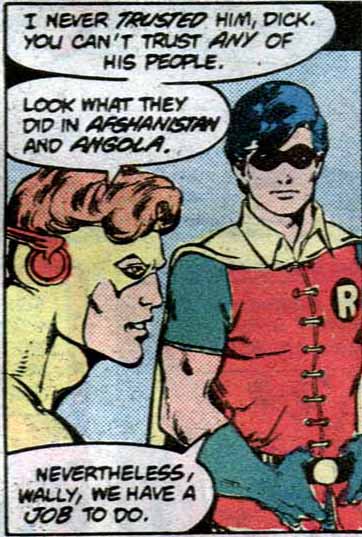 The New Teen Titans #18
The New Teen Titans #18
Later, under Gorbachev, Moscow and Washington agree to an exchange of knowledge, so Starfire goes back to the US for Americans to study his powers. Suspicious of glasnost, some members of the politburo secretly send super-agents Hammer and Sickle (who totally look like Ivan and Ludmilla Drago) to kill Starfire – going against the Teen Titans in the process:
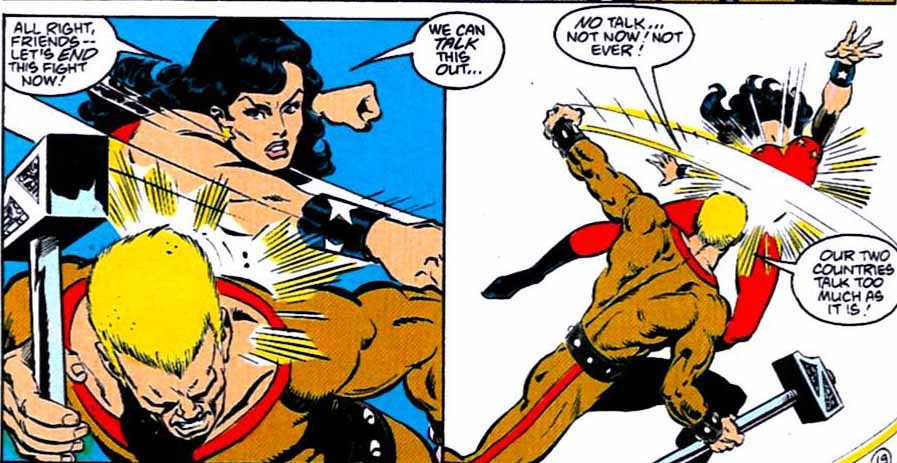 The New Teen Titans (v2) #48
The New Teen Titans (v2) #48
Leave it to writer Marv Wolfman to cram in a discussion about Soviet politics in the middle of a superhero slugfest:
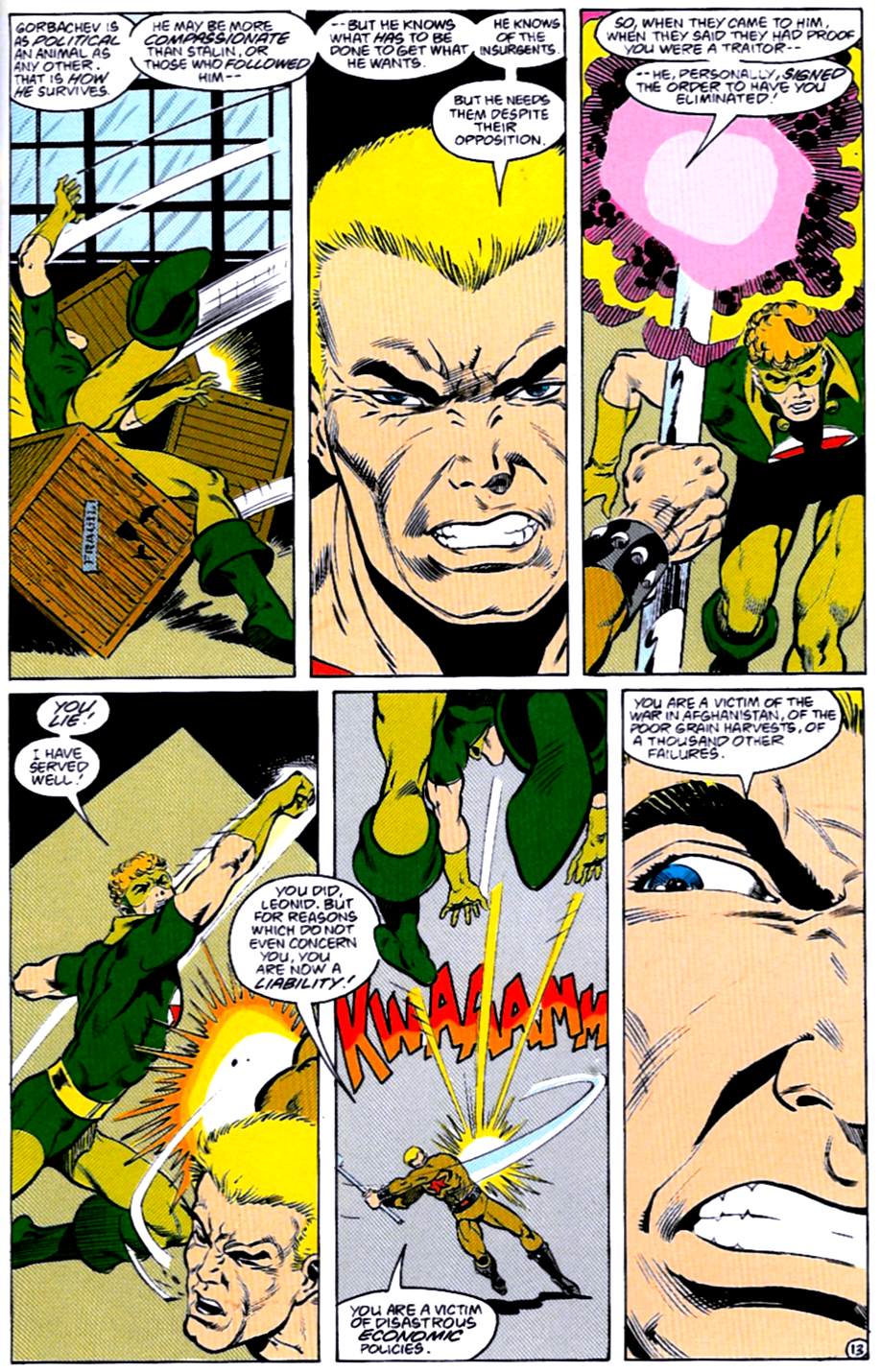 The New Teen Titans (v2) #49
The New Teen Titans (v2) #49
Starfire – having reinvented himself as Red Star – ends up joining the Titans shortly before the collapse of the USSR. As far as I can tell, the two events aren’t connected, but feel free to go at it, conspiracy theorists!
As far as I’m concerned, the best use of the Soviet-agent-gone-rogue trope takes place in Batman #393-394, one of the greatest Batman stories of the ’80s (which is saying something).
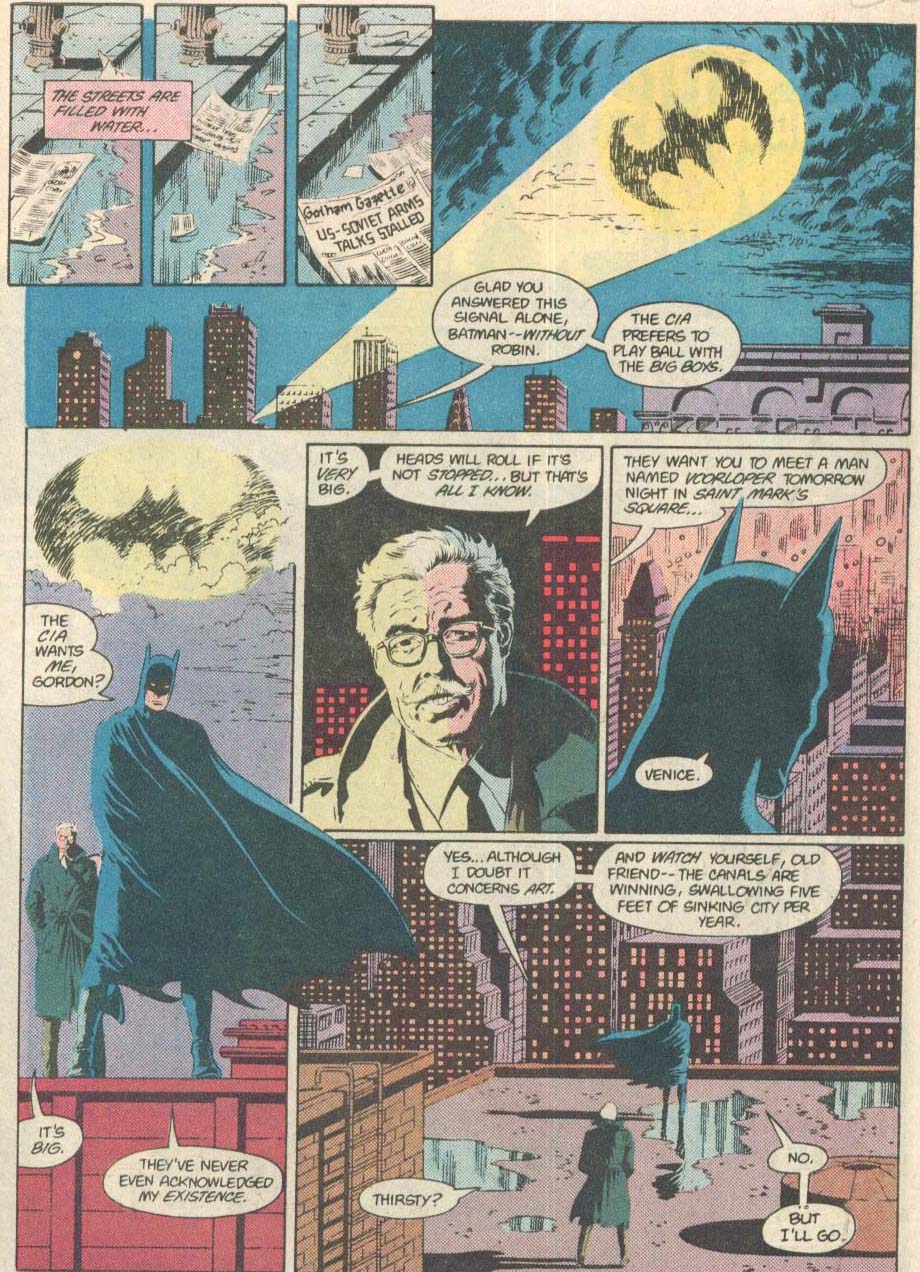 Batman #393
Batman #393
On the face of it, it’s just more of the same: a renegade KGB operative out of Bulgaria, called the Dark Rider, wants to carry out a terrorist attack against the US, so Batman partners up with a Russian spy, Katia, in order to stop him and prevent war between their nations.
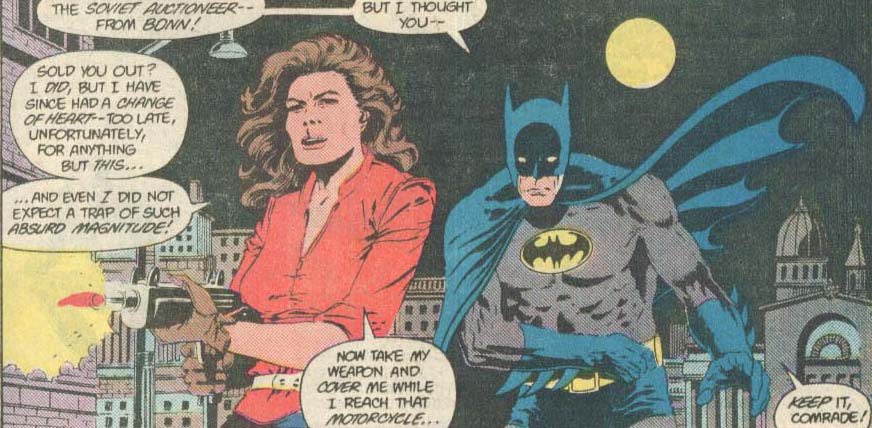 Batman #393
Batman #393
This tale fits into the tradition of grand espionage adventures, with the Caped Crusader chasing a plutonium-filled MacGuffin (the pre-revolutionary statue of a Cossack horseman, which comes to represent the Dark Rider himself) through Venice, Bonn, Moscow, and Switzerland, all brought to life by Paul Gulacy’s breathtakingly cinematographic art.
The whole thing is packed with neat, little touches… When sieging the Dark Rider in the story’s climax, Katia says ‘We split up here – I’ll go around the back.’ and Robin points out that’s usually the Batman’s line, to which she replies ‘It will take more than a “line” to save this night.’ However, in the end the Dynamic Duo save everyone precisely by wrapping an actual line around the Dark Rider’s feet! Moreover, as you probably gathered from the first page scan, there is a whole water leitmotif running through these comics. Indeed, rain, the Venice canals, thirst, snow, a bathtub, ice cubes, a water cooler, and the Gotham waterfront and reservoir all play a part in the story. That said, writer Doug Moench does go a bit overboard with the metaphor in the last page:
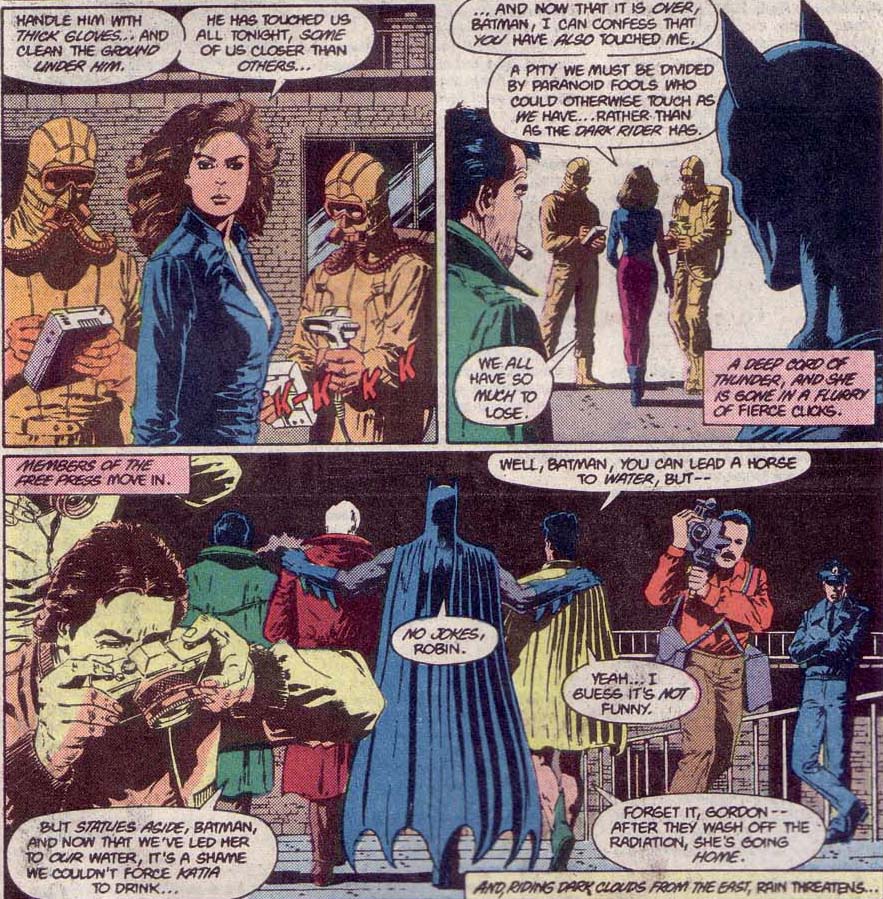 Batman #394
Batman #394
If Moench’s tale can be accused of pretentiousness, the same charge can never be made of Jim Starlin’s ‘Ten Nights of the Beast,’ which is grindhouse all the way… This time around, an obscure cell within the ranks of the USSR’s secret services, just before it gets closed down by Gorbachev, sends out its best assassin to kill 10 people involved with Reagan’s ‘Star Wars’ defense system (including Reagan himself, who is attending a Republican convention in Gotham City). The assassin is known as KGBeast – and while this is a silly name, at least it matches his sartorial choices:
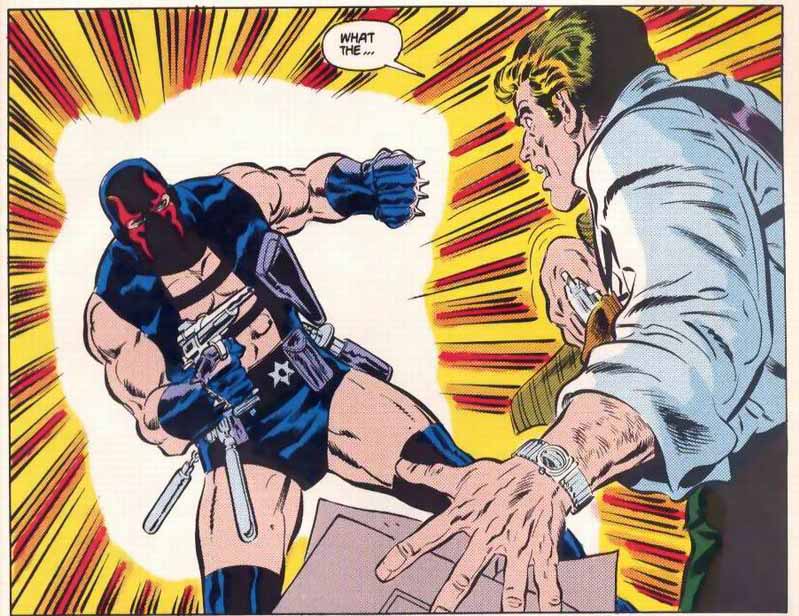 Batman #417
Batman #417
Although his hit list consists of 10 names, the KGBeast kills more than 100 people before the story is over… But hey, at least Batman manages to save Ronald Reagan, and not for the first time (besides the attack on Camp David I described in my last post, the Caped Crusader also saved the Gipper when Greek-themed villain Maxie Zeus tried to take over the 1984 L.A. Olympics, in Batman and the Outsiders #15).
On top of all the schlock, ‘Ten Nights of the Beast’ includes the lowest point in Jim Aparo’s long career of illustrating Batman comics, namely the infamous scene in which the KGBeast gets his hand trapped by a rope, with Batman hanging on the other end…
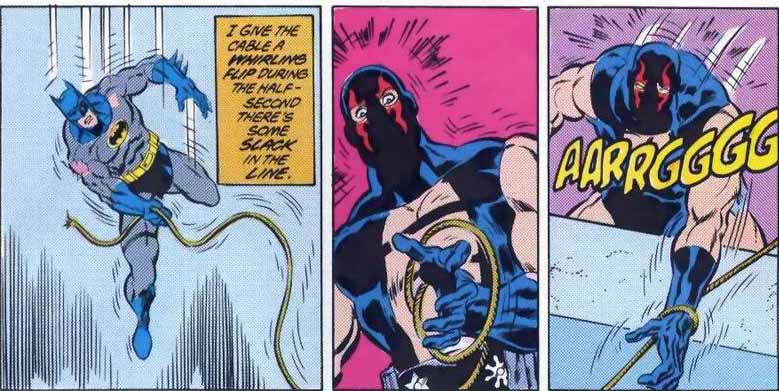 Batman #419
Batman #419
The way this sequence is drawn, it looks as if the super-resourceful Russian assassin can simply get out of it by cutting the rope. But for some unclear reason, he chooses the next best thing and CHOPS HIS OWN HAND OFF!
The scene is so puzzling that Marv Wolfman feels the need to address it in the sequel. Set in 1990, ‘When the Earth Dies!’ sees Batman travelling to Moscow to prevent KGBeast’s protégé, NKVDemon (yes, they went there), from murdering 10 Russians behind glasnost and perestroika, including Premier Mikhail Gorbachev, considered to have betrayed the Soviet Union and violated the tenets of Marxism. Thus, Jim Aparo gets to draw an alternative, more logical ending to the roped hand scenario:
 Batman #446
Batman #446
And Wolfman once again gets to write some hilariously mismatched dialogue for such eccentrically clad characters:
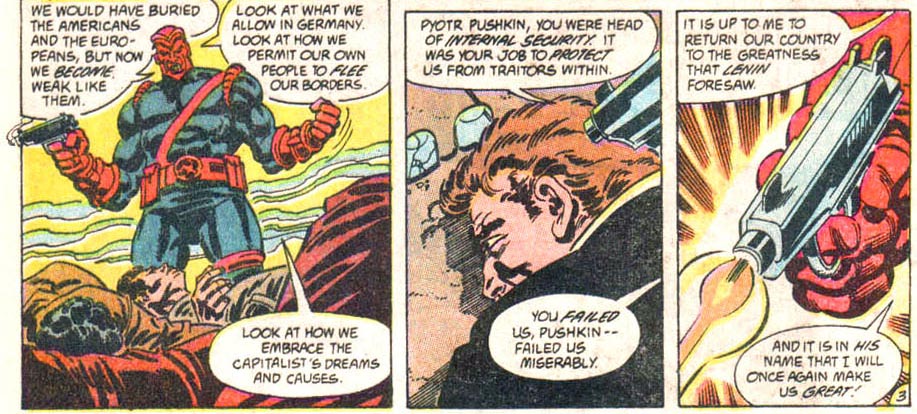 Batman #447
Batman #447
After the breakdown of the USSR, DC was left with a bunch of outdated Soviet villains. In 1994, ‘Troika’ revisited some of the Russian characters still hanging around Gotham City, including the Dark Rider and the KGBeast…
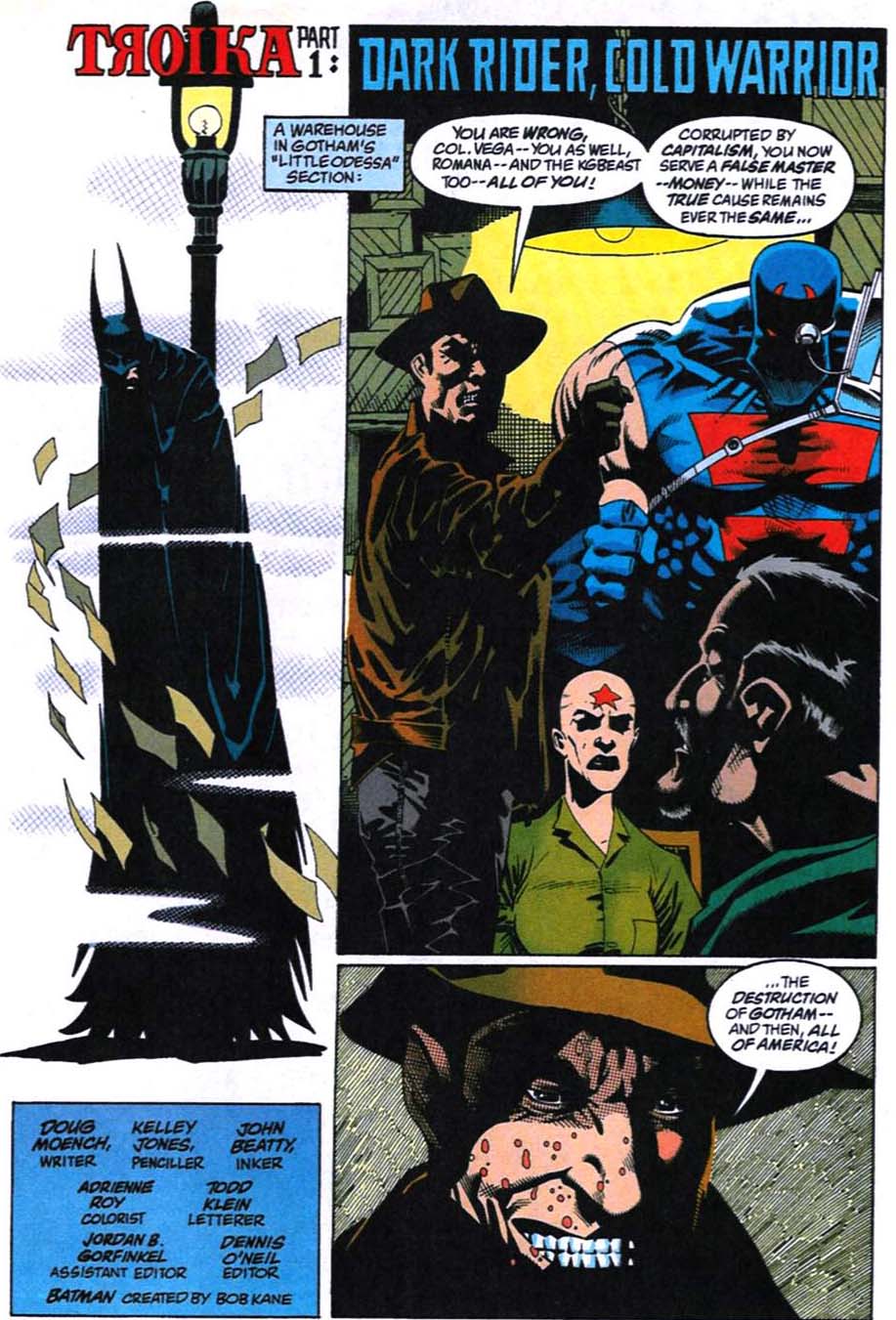 Batman #515
Batman #515
The joke is that by now, like the oligarchs back home, many of these characters fully embrace the most savage side of capitalism:
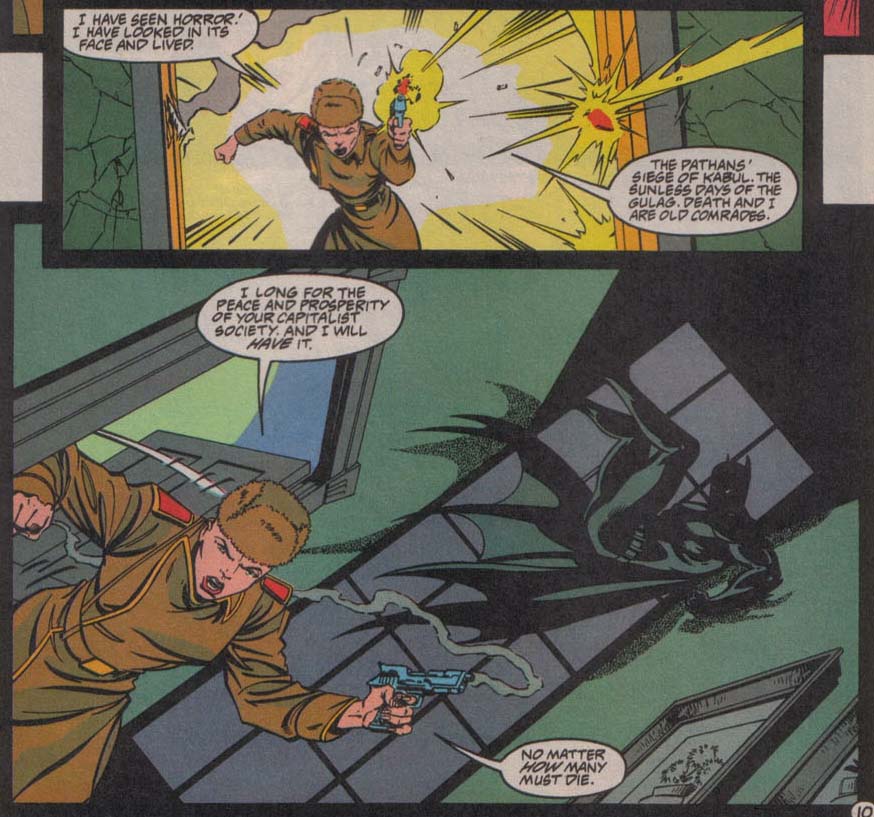 Robin (v4) #14
Robin (v4) #14
The KGBeast continued to pop up in Batman comics occasionally, suffering from a classic case of villain decay. The assassin that once made Gotham shake with a triple digit body count gradually found himself reduced to a pathetic running joke… In 2006, someone finally put him out of his misery:
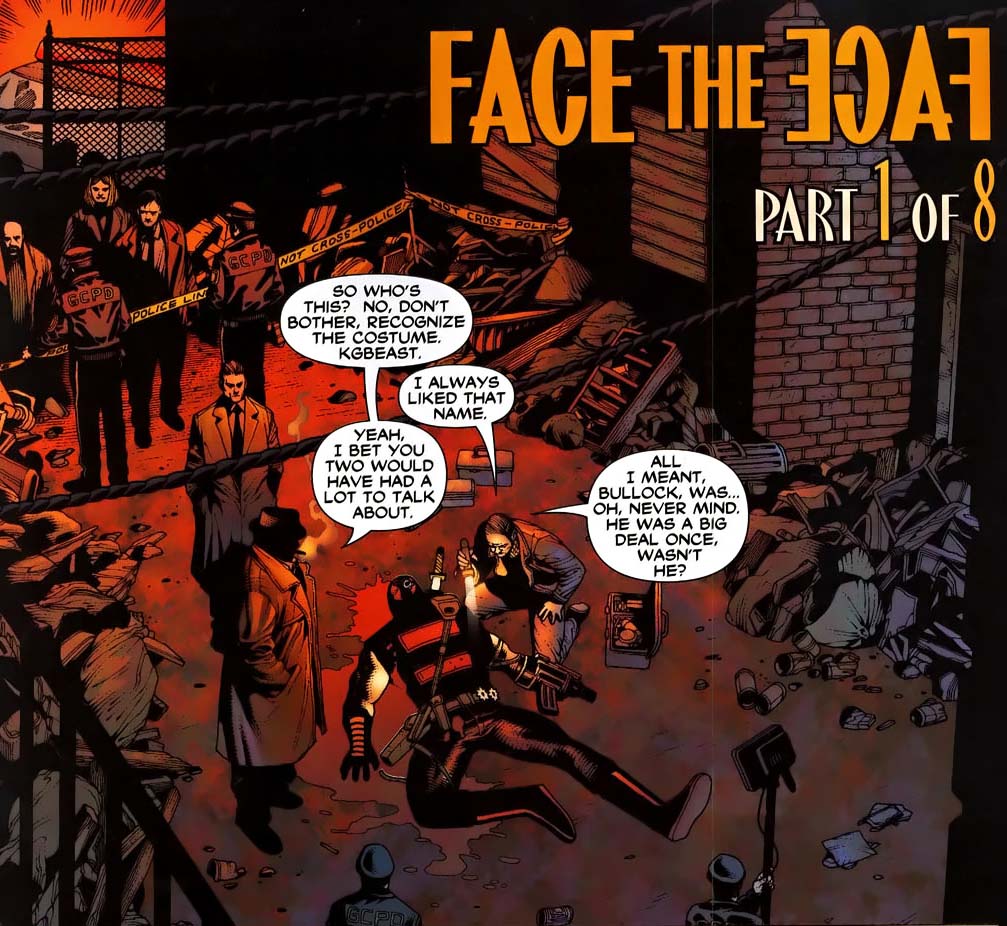 Detective Comics #817
Detective Comics #817
Still, I guess it’s a matter of time until we get a story where Vladimir Putin brings him back to life…

